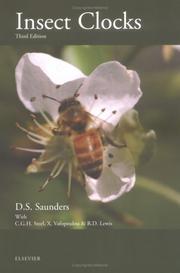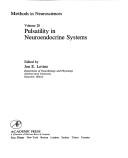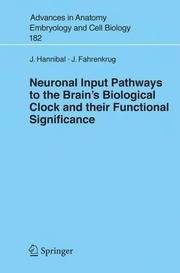| Listing 1 - 10 of 17 | << page >> |
Sort by
|

ISBN: 0444504079 9786611029524 1281029521 0080534716 9780444504074 9780080534718 Year: 2002 Publisher: Amsterdam ; Boston : Elsevier,
Abstract | Keywords | Export | Availability | Bookmark
 Loading...
Loading...Choose an application
- Reference Manager
- EndNote
- RefWorks (Direct export to RefWorks)
Chronobiology is the study of timing mechanisms in biological systems as diverse as plants, animals and some micro-organisms. It includes rhythmic phenomena ranging from short period (ultradian) through daily (circadian) to long period (monthly, annual) cycles of behaviour, physiology and biochemistry. In recent years spectacular advances have been made, particularly in the field of circadian rhythms, and hardly a week passes without important papers appearing in the major scientific journals. The third edition of Insect Clocks, like its predecessors, deals with the properties and
Insects --- Biological rhythms. --- Physiology. --- Behavior. --- Biological clocks --- Biology --- Biorhythms --- Endogenous rhythms --- Living clocks --- Rhythms, Biological --- Chronobiology --- Cycles --- Pacemaker cells --- Insect behavior --- Periodicity --- Insects - Physiology. --- Insects - Behavior.
Book
ISBN: 0674069692 0674065859 0674065484 9780674065482 9780674065857 9780674069695 Year: 2012 Publisher: Cambridge, MA
Abstract | Keywords | Export | Availability | Bookmark
 Loading...
Loading...Choose an application
- Reference Manager
- EndNote
- RefWorks (Direct export to RefWorks)
Early birds and night owls are born, not made. Sleep patterns may be the most obvious manifestation of the highly individualized biological clocks we inherit, but these clocks also regulate bodily functions from digestion to hormone levels to cognition. Living at odds with our internal timepieces, Till Roenneberg shows, can make us chronically sleep deprived and more likely to smoke, gain weight, feel depressed, fall ill, and fail geometry. By understanding and respecting our internal time, we can live better.Internal Time combines storytelling with accessible science tutorials to explain how our internal clocks work-for example, why morning classes are so unpopular and why "lazy" adolescents are wise to avoid them. We learn why the constant twilight of our largely indoor lives makes us dependent on alarm clocks and tired, and why social demands and work schedules lead to a social jet lag that compromises our daily functioning.Many of the factors that make us early or late "chronotypes" are beyond our control, but that doesn't make us powerless. Roenneberg recommends that the best way to sync our internal time with our external environment and feel better is to get more sunlight. Such simple steps as cycling to work and eating breakfast outside may be the tickets to a good night's sleep, better overall health, and less grouchiness in the morning.
Chronobiology. --- Biological rhythms. --- Biological clocks --- Biology --- Biorhythms --- Endogenous rhythms --- Living clocks --- Rhythms, Biological --- Chronobiology --- Cycles --- Pacemaker cells --- Biological time --- Time --- Periodicity

ISBN: 012185289X 9780121852894 148328834X Year: 1994 Publisher: San Diego, California : Academic Press,
Abstract | Keywords | Export | Availability | Bookmark
 Loading...
Loading...Choose an application
- Reference Manager
- EndNote
- RefWorks (Direct export to RefWorks)
Pulsatility is now recognized as a nearly ubiquitous functional feature of neuroendocrine systems. This volume presents a comprehensive guide to the established and emerging technologies being used to study the perplexing phenomenon of pulsatility. Molecular, cellular, physiological, and mathematical approaches are described in detail.Comprehensive protocols included for the study of* In vitro methods for studying neuroendocrine pulsatility* In vivo sampling and recording procedures for monitoring pulsatility in several species* Improved quantitative and analy
Paraneurons. --- Biological rhythms. --- Cell interaction. --- Cell-cell interaction --- Cell communication --- Cellular communication (Biology) --- Cellular interaction --- Intercellular communication --- Cellular control mechanisms --- Biological clocks --- Biology --- Biorhythms --- Endogenous rhythms --- Living clocks --- Rhythms, Biological --- Chronobiology --- Cycles --- Pacemaker cells --- Neuroendocrine cells --- Neurons --- Chromaffin cells --- Periodicity

ISSN: 16153871 ISBN: 1281065781 9786611065782 354072110X 3540721096 364209127X Year: 2007 Publisher: Berlin ; New York : Springer,
Abstract | Keywords | Export | Availability | Bookmark
 Loading...
Loading...Choose an application
- Reference Manager
- EndNote
- RefWorks (Direct export to RefWorks)
The development of a bio-engineered pacemaker is of substantial clinical and also scientific interest because it promises to overcome several limitations of electronic pacemakers. Moreover it may answer the longstanding question of whether the complex structure of the sinus node is indeed a prerequisite for reliable pacemaking, or simpler structures might work as well. This book gives an overview of the current state-of-the-art of creating a bio-engineered pacemaker. It shows the approaches to develop of genetic and cell-based engineering methods suitable to implement them with safety and stability. It also illuminates the problems that need to be solved before bio-pacemaking can be considered for clinical use.
Biological rhythms. --- Pacemaker cells. --- Mathematical Sciences --- Applied Mathematics --- Engineering. --- Human physiology. --- Cardiology. --- Application software. --- Biophysics. --- Biological physics. --- Biomedical engineering. --- Biomedical Engineering. --- Human Physiology. --- Computer Applications. --- Biophysics and Biological Physics. --- Clinical engineering --- Medical engineering --- Bioengineering --- Biophysics --- Engineering --- Medicine --- Biological physics --- Biology --- Medical sciences --- Physics --- Application computer programs --- Application computer software --- Applications software --- Apps (Computer software) --- Computer software --- Heart --- Internal medicine --- Human biology --- Physiology --- Human body --- Construction --- Industrial arts --- Technology --- Diseases --- Biological pacemakers --- Natural pacemakers --- Pacemakers, Biological --- Cells --- Biological rhythms --- Biological clocks --- Biorhythms --- Endogenous rhythms --- Living clocks --- Rhythms, Biological --- Chronobiology --- Cycles --- Pacemaker cells --- Periodicity --- Computer science. --- Biomedical Engineering and Bioengineering. --- Biological and Medical Physics, Biophysics. --- Informatics --- Science

ISBN: 1280613033 9786610613038 3540277897 3540277889 Year: 2006 Publisher: Berlin ; New York : Springer,
Abstract | Keywords | Export | Availability | Bookmark
 Loading...
Loading...Choose an application
- Reference Manager
- EndNote
- RefWorks (Direct export to RefWorks)
Circadian rhythms are entrained daily by environmental photic and non-photic cues. The present review describes the anatomy and functional characteristics of the three major input pathways to the circadian clock mediating entrainment, the retino-hypothalamic tract (RHT), the geniculo-hypothalamic tract (GHT) and the midbrain raphe projection.
Suprachiasmatic nucleus. --- Biological rhythms. --- Biological clocks --- Biology --- Biorhythms --- Endogenous rhythms --- Living clocks --- Rhythms, Biological --- Chronobiology --- Cycles --- Pacemaker cells --- Nucleus, Suprachiasmatic --- Hypothalamus --- Periodicity --- Medicine. --- Biomedicine general. --- Clinical sciences --- Medical profession --- Human biology --- Life sciences --- Medical sciences --- Pathology --- Physicians --- Biomedicine, general. --- Health Workforce --- Medicine --- Biomedical Research. --- Research. --- Biological research --- Biomedical research
Book
ISBN: 1612098614 9781612098616 1607412519 9781607412519 Year: 2010 Publisher: New York
Abstract | Keywords | Export | Availability | Bookmark
 Loading...
Loading...Choose an application
- Reference Manager
- EndNote
- RefWorks (Direct export to RefWorks)
Biological rhythms. --- Circadian rhythms. --- Behavior, Circadian --- Biological clocks, Daily --- Circadian behavior --- Circadian clocks --- Circadian cycles --- Clocks, Circadian --- Cycles, Circadian --- Daily activity cycles --- Daily biological clocks --- Diel cycles --- Diurnal rhythms --- Rhythms, Circadian --- Biological rhythms --- Biological clocks --- Biology --- Biorhythms --- Endogenous rhythms --- Living clocks --- Rhythms, Biological --- Chronobiology --- Cycles --- Pacemaker cells --- Periodicity
Book
ISBN: 3030556433 3030556425 Year: 2020 Publisher: Cham, Switzerland : Springer,
Abstract | Keywords | Export | Availability | Bookmark
 Loading...
Loading...Choose an application
- Reference Manager
- EndNote
- RefWorks (Direct export to RefWorks)
This book explores how daily and seasonal rhythmicity is generated, how these rhythms are synchronised by our environment, and how they regulate the neuroendocrine systems that impact our physiology and behaviour. The constraints of surviving in a seasonal environment have shaped human evolution and migration, have shaped our societies and cultures, and continue to influence our everyday lives, health and wellbeing. Identifying the mechanisms whereby seasonal rhythmicity is generated and regulates the brain and body is not only important for understanding the natural world and relevant to animal production, it also offers many insights into the human condition. Each chapter is written by an international expert in the field of chronobiology. A historical perspective on how research into photoperiodism and rhythmicity progressed is initially provided, but the main focus of this book is on the remarkable studies in the last few decades that have unravelled the molecular and cellular machinery underpinning circadian and circannual timing. Topics covered include the role of melatonin in communicating seasonal information to the brain and pituitary gland, the neuroanatomical pathways in mammals, birds and fish by which changes in photoperiod reach the hypothalamus, the role of glial cells (tanycytes) and thyroid hormone in seasonal rhythmicity, neuroplasticity across seasons, effects of changing day length on mood, regulation of “clock“ gene expression, and the role of the suprachiasmatic nucleus. This book will appeal to all students and researchers who wish to learn about current and past research on daily and seasonal rhythmicity. This is the tenth volume in the International Neuroendocrine Federation (INF) Masterclass in Neuroendocrinology series (Volumes 1-7 published by Wiley) that aims to illustrate highest standards and encourage the use of the latest technologies in basic and clinical research and hopes to provide inspiration for further exploration into the exciting field of neuroendocrinology. .
Neurosciences. --- Human anatomy. --- Anatomy. --- Anatomy, Human --- Anatomy --- Human biology --- Medical sciences --- Human body --- Neural sciences --- Neurological sciences --- Neuroscience --- Nervous system --- Neuroendocrinology. --- Biological rhythms. --- Biological clocks --- Biology --- Biorhythms --- Endogenous rhythms --- Living clocks --- Rhythms, Biological --- Chronobiology --- Cycles --- Pacemaker cells --- Endocrinology --- Neurology --- Neurohormones --- Periodicity
Book
ISBN: 3030601811 3030601803 Year: 2020 Publisher: Cham, Switzerland : Springer,
Abstract | Keywords | Export | Availability | Bookmark
 Loading...
Loading...Choose an application
- Reference Manager
- EndNote
- RefWorks (Direct export to RefWorks)
This book presents coverage of the principles and practice of molecular clocks, which have provided fascinating and unprecedented insights into the evolutionary timescale of life on earth. It begins by following the early development of the molecular evolutionary clock in the 1960s, and leads to the complex statistical approaches that are now used to analyse genome sequences. The chapters of this book have been contributed by leading experts in the field and address the important issues of evolutionary rates, molecular dating, and phylogenomic analysis. This is the first time that these different aspects of the molecular clock have been brought together in a single, comprehensive volume. It is an invaluable reference for students and researchers interested in evolutionary biology, genetic analysis, and genomic evolution. .
Evolutionary biology. --- Bioinformatics. --- Evolutionary Biology. --- Bio-informatics --- Biological informatics --- Biology --- Information science --- Computational biology --- Systems biology --- Animal evolution --- Animals --- Biological evolution --- Darwinism --- Evolutionary biology --- Evolutionary science --- Origin of species --- Evolution --- Biological fitness --- Homoplasy --- Natural selection --- Phylogeny --- Data processing --- Molecular evolution. --- Biological rhythms. --- Biological clocks --- Biorhythms --- Endogenous rhythms --- Living clocks --- Rhythms, Biological --- Chronobiology --- Cycles --- Pacemaker cells --- Biochemical evolution --- Chemical evolution --- Life --- Molecular biology --- Periodicity --- Origin
Book
ISBN: 9811941882 9811941890 Year: 2022 Publisher: Singapore : Springer Nature Singapore Pte Ltd.,
Abstract | Keywords | Export | Availability | Bookmark
 Loading...
Loading...Choose an application
- Reference Manager
- EndNote
- RefWorks (Direct export to RefWorks)
Biosensors. --- Signal processing. --- Biological rhythms. --- Biological clocks --- Biology --- Biorhythms --- Endogenous rhythms --- Living clocks --- Rhythms, Biological --- Chronobiology --- Cycles --- Pacemaker cells --- Processing, Signal --- Information measurement --- Signal theory (Telecommunication) --- Biodetectors --- Biological detectors --- Biological sensors --- Biomedical detectors --- Biomedical sensors --- Detectors --- Medical instruments and apparatus --- Physiological apparatus --- Periodicity
Book
ISBN: 1402047010 Year: 2006 Publisher: Dordrecht : Springer Netherlands : Imprint: Springer,
Abstract | Keywords | Export | Availability | Bookmark
 Loading...
Loading...Choose an application
- Reference Manager
- EndNote
- RefWorks (Direct export to RefWorks)
Biological rhythms are a fundamental property of all life and encompass a wide range of frequencies, from seconds to a century or more. Introducing Biological Rhythms is a primer that serves to introduce individuals to the area of biological rhythms. It describes the major characteristics and discusses the implications and applications of these rhythms, while citing scientific results and references. Also, the primer includes essays that provide in-depth historic and other background information for those interested in more specific topics or concepts. Introducing Biological Rhythms covers a basic cross-section of the field of chronobiology clearly enough so that it can be understood by a novice, or an undergraduate student, but it is also sufficiently technical and detailed for the scientist. "[Koukkari and Sothern] deal with the basic information at the beginning of the book and with applications at the end. The Essays attached to each chapter are very useful digressions and the ‘Take Home Message’ a good idea." - Dr. B. Millet, Université de Franche-Comté (Besançon, France).
Biological rhythms. --- Chronobiology. --- Biological time --- Biology --- Time --- Biological clocks --- Biorhythms --- Endogenous rhythms --- Living clocks --- Rhythms, Biological --- Chronobiology --- Cycles --- Pacemaker cells --- Periodicity --- Life sciences. --- Botany. --- Animal physiology. --- Biodiversity. --- Life Sciences, general. --- Plant Sciences. --- Animal Physiology. --- Animal physiology --- Animals --- Anatomy --- Botanical science --- Phytobiology --- Phytography --- Phytology --- Plant biology --- Plant science --- Natural history --- Plants --- Biosciences --- Sciences, Life --- Science --- Biological diversification --- Biological diversity --- Biotic diversity --- Diversification, Biological --- Diversity, Biological --- Biocomplexity --- Ecological heterogeneity --- Numbers of species --- Physiology --- Plant science. --- Floristic botany
| Listing 1 - 10 of 17 | << page >> |
Sort by
|

 Search
Search Feedback
Feedback About UniCat
About UniCat  Help
Help News
News